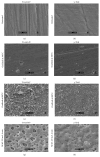Titanium Oxide: A Bioactive Factor in Osteoblast Differentiation
- PMID: 26664360
- PMCID: PMC4667015
- DOI: 10.1155/2015/357653
Titanium Oxide: A Bioactive Factor in Osteoblast Differentiation
Abstract
Titanium and titanium alloys are currently accepted as the gold standard in dental applications. Their excellent biocompatibility has been attributed to the inert titanium surface through the formation of a thin native oxide which has been correlated to the excellent corrosion resistance of this material in body fluids. Whether this titanium oxide layer is essential to the outstanding biocompatibility of titanium surfaces in orthopedic biomaterial applications is still a moot point. To study this critical aspect further, human fetal osteoblasts were cultured on thermally oxidized and microarc oxidized (MAO) surfaces and cell differentiation, a key indicator in bone tissue growth, was quantified by measuring the expression of alkaline phosphatase (ALP) using a commercial assay kit. Cell attachment was similar on all the oxidized surfaces although ALP expression was highest on the oxidized titanium alloy surfaces. Untreated titanium alloy surfaces showed a distinctly lower degree of ALP activity. This indicates that titanium oxide clearly upregulates ALP expression in human fetal osteoblasts and may be a key bioactive factor that causes the excellent biocompatibility of titanium alloys. This result may make it imperative to incorporate titanium oxide in all hard tissue applications involving titanium and other alloys.
Figures




References
-
- Rack H. J., Qazi J. I. Titanium alloys for biomedical applications. Materials Science and Engineering C. 2006;26(8):1269–1277. doi: 10.1016/j.msec.2005.08.032. - DOI
-
- Nicolaije C., Koedam M., van Leeuwen J. P. T. M. Decreased oxygen tension lowers reactive oxygen species and apoptosis and inhibits osteoblast matrix mineralization through changes in early osteoblast differentiation. Journal of Cellular Physiology. 2012;227(4):1309–1318. doi: 10.1002/jcp.22841. - DOI - PubMed
Grants and funding
LinkOut - more resources
Full Text Sources
Other Literature Sources

